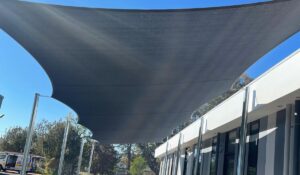Shade sails have become a popular solution for enhancing outdoor spaces, offering stylish protection against the sun while transforming patios, gardens, and pool areas into comfortable retreats. However, the longevity and performance of shade sails depend largely on the materials used. Durable materials ensure UV resistance, weather resilience, and long-term satisfaction, making the choice of fabric a key factor in your investment.
In this guide, we’ll explore the best materials for shade sails, highlight their durability features, and help you make an informed decision for lasting comfort and style.
Understanding Shade Sail Materials
Common Shade Sail Fabrics
1. High-Density Polyethylene (HDPE):
HDPE is the most popular and widely used material for shade sails due to its durability and exceptional UV resistance. It’s a woven synthetic fabric designed to allow airflow while blocking harmful UV rays.
- Strength and Breathability: HDPE offers a balance of air circulation and shade, keeping spaces cool without trapping heat.
- UV Protection: Premium HDPE fabrics can block up to 98% of harmful UV rays, preventing sun damage.
- Types of HDPE: Mesh HDPE is ideal for windy environments, while solid weave HDPE provides enhanced shade and rain protection.
- Climate Suitability: It’s perfect for harsh climates, including coastal and desert regions, where UV exposure is intense.
2. Polyester:
Polyester is valued for its versatility and cost-effectiveness. When treated with UV stabilizers, it becomes a durable option for outdoor applications.
- Color Options: Polyester is available in various colors and styles, allowing for aesthetic flexibility.
- UV Stabilizers: Choosing high-quality polyester with UV protection prevents fading and degradation over time.
- Best Use: It works well for temporary or decorative shade sails but may not be as durable as HDPE for heavy-duty use.
3. Acrylic:
Acrylic is a premium material known for its durability, strength, and exceptional colorfastness.
- Superior Color Retention: Acrylic fabrics retain their vibrant colors longer than most other materials.
- Mildew Resistance: Acrylic’s resistance to mold and mildew makes it ideal for humid climates.
- High-End Quality: While more expensive, acrylic shade sails offer unmatched performance and aesthetic appeal.
4. Canvas:
Canvas offers a natural, breathable fabric option, often chosen for its traditional look and feel.
- Natural Appeal: Canvas complements classic outdoor settings beautifully.
- Potential Drawbacks: Without proper care, canvas is prone to shrinkage, mildew, and wear in humid conditions.
- Maintenance Tip: Regular cleaning and waterproof treatments can help extend the life of canvas shade sails.
Key Factors to Consider When Choosing Materials
1. UV Resistance
UV protection is vital for preventing material degradation and ensuring your shade sail effectively blocks harmful sun rays. Look for fabrics with UV stabilizers and high UPF ratings (Ultraviolet Protection Factor). For example, HDPE fabrics often boast a UPF of 50+, meaning they block 98% of UV radiation.
2. Weather Resistance
Outdoor materials must withstand rain, wind, and temperature fluctuations. Weather-resistant fabrics like HDPE and acrylic perform well under tough conditions. Treatments such as water repellents help prevent mold and mildew, while strong fibers reduce wear from wind exposure.
3. Strength and Tear Resistance
Durability depends on the strength of the fibers and the weave of the fabric. High-density materials with reinforced edges and durable stitching prevent tears under tension and high winds. Assessing the fabric thickness (measured in GSM—grams per square meter) is also a good indicator of strength.
Comparing Material Durability
HDPE vs. Polyester:
HDPE outperforms polyester in UV resistance and overall strength, making it ideal for long-term use. Polyester, while versatile, may fade or degrade faster under harsh sun exposure.
Polyester vs. Acrylic:
Acrylic is a higher-end material with superior color retention and mildew resistance, but it comes at a premium price. Polyester, although less durable, offers a budget-friendly alternative for light use.
Acrylic vs. Canvas:
Acrylic provides greater durability, weather resistance, and colorfastness compared to canvas. Canvas appeals to those who prefer a natural aesthetic but requires diligent care to avoid mildew and shrinkage.
Maintenance and Care for Long-Lasting Shade Sails
To extend the lifespan of your shade sails, regular maintenance is key.
1. Regular Cleaning:
- Use mild detergent and a soft brush to remove dirt, dust, and mildew.
- Avoid harsh chemicals or pressure washing, as these can damage the fabric.
2. Proper Storage:
- Remove shade sails during extreme weather conditions or the off-season.
- Store them in a cool, dry place, preferably in protective bags, to avoid mold growth or wear.
3. Professional Inspection and Repair:
- Schedule regular inspections to identify frayed edges, loose stitching, or minor tears.
- Address issues promptly to prevent further damage, ensuring the longevity of your shade sail.
Conclusion
Choosing the best material for your shade sail is crucial for durability and long-lasting performance. HDPE stands out for its strength and UV resistance, while acrylic offers a premium solution with exceptional colorfastness and mildew protection. Understanding your environment, maintenance requirements, and budget will help you make the right choice.
Investing in high-quality, durable materials ensures your shade sail remains a stylish and functional addition to your outdoor space for years to come. For expert guidance or premium shade solutions, consult with a professional supplier today!







